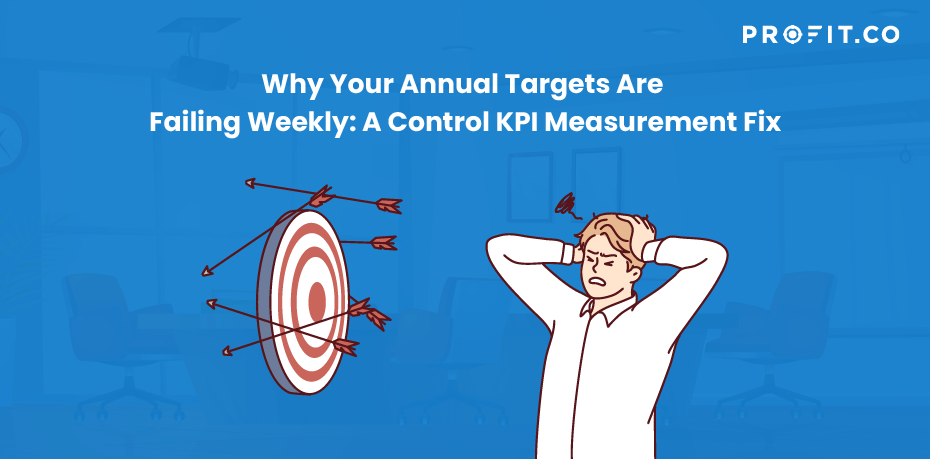“In God we trust , All others must bring data.”
Why Does This Happen?
Traditional control KPI measurement methods, such as sum or Average, assume that each reporting period is independent. That works fine when the target resets every period (e.g., daily calls, weekly customer satisfaction scores). But cumulative goals, like annual revenue or yearly budgets, don’t reset but accumulate- The sum keeps adding values, but without considering pacing against the annual target.
- Average smooths data, but hides whether you’re on a cumulative track or not.
- Check-ins measure activity frequency, not actual progress toward a total.
What Is “Distance from Target” in KPI Measurement?
“Distance from Target” is a KPI measurement type that tracks how close you are to your long-term goal at any point in time, instead of treating the full target as something you must achieve in every reporting period.- If your annual target is $1.2M in revenue, the system calculates where you should be by week, month, or quarter based on pacing
- Your actuals are then compared against that expected cumulative value.
- The result tells you if you’re ahead, behind, or exactly on track, without creating false alarms.
Real Example:
- Annual target: $1.2 million
- Week 10 actual revenue: $230,000
- Expected by week 10: $230,769 (roughly $1.2 M ÷ 52 weeks × 10)
- Distance from target: You’re actually slightly ahead!
When it’s not the right fit:
- When your goals are truly per-period resets (e.g., “100 sales calls per week” or “CSAT 90% every month”), “Distance from Target” would give false reassurance because each period should stand on its own.
- When your goals are truly per-period resets (e.g., “100 sales calls per week” or “CSAT 90% every month”), “Distance from Target” would give false reassurance because each period should stand on its own.
Want to choose the right KPI?
Why Traditional Control KPI Systems Fail
Most KPI dashboards were originally designed for short-cycle, repeatable metrics like sales calls, tickets closed, or uptime percentages. These are easy to measure because they reset each period. But when organizations began using KPIs for strategic, long-term goals like annual revenue or multi-quarter budgets, these same measurement models were applied incorrectly. This mismatch is why many dashboards flag false failures: they weren’t built for cumulative trajectories, but for periodic snapshots.| Mesurement Type | Best for | Weakness | Example Use case |
|---|---|---|---|
| Sum | Adds up total values over time | Doesn’t align with cumulative pacing; can overstate progress early or late | Total tickets closed this quarte |
| Average | Smooths performance across periods | Hides cumulative trajectory; not good for long-term goals | Average customer satisfaction score per week |
| Successful Check-ins | Tracks the frequency of meeting targets | Focuses on activity, not actual progress | Number of times the sales team hit the weekly call target |
| Distance from Target | Tracks progress against the cumulative goal over time | Not suited for per-period reset goals | Annual revenue pacing, quarterly budget tracking |
The Quick Fix That Changes Everything
Here’s your step-by-step solution: Step 1: Navigate to your KPI settings Step 2:Find the measurement type dropdown Step 3:Change from “Sum,” “Average,” or “Successful Check-ins” to “Distance from Target” Step 4:Set the target direction to “At Most” (for budgets) or “At Least” (for revenue goals)When to Use What
Use “Distance from Target” when:
- You have annual, quarterly, or monthly cumulative targets
- You’re tracking budgets, revenue, or any goal that builds over time
- You want to see progress toward a long-term objective
Stick with “Sum” or “Average” when:
- You need to hit the same target every period
- You’re measuring things like daily customer satisfaction scores
- Each reporting period should meet the full target independently
Why This Matters More Than You Think
Getting KPI measurements right isn’t just about avoiding confusion. It’s about:- Better decision-making: Accurate data leads to smarter choices
- Reduced stress: Teams stop panicking over false alarms
- Improved performance: People focus on real gaps, not system errors
- Increased trust: When dashboards make sense, people actually use them




